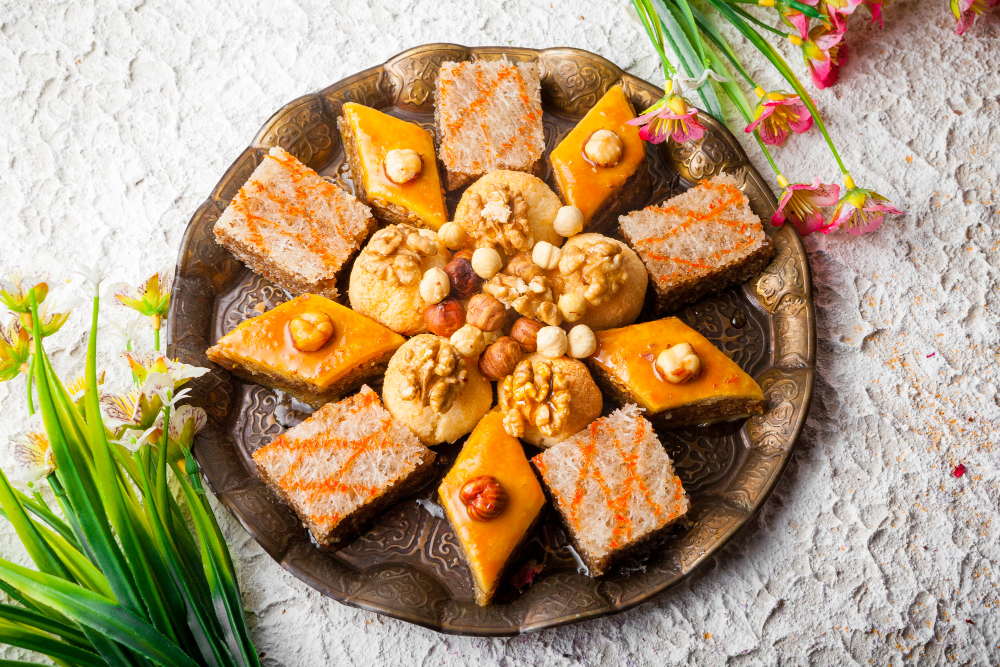Indian sweets, or mithai, are an integral part of Indian culture. They are synonymous with celebrations, festivals, and joyous occasions. Every bite of these delectable treats is a burst of flavour, a testament to the rich culinary heritage of India.
A Kaleidoscope of Flavors
Indian sweets are a diverse and colourful world, each region boasting its own unique specialities.
Milk-Based Delights:
- Rasgulla: A sweet syrup is used to bathe these soft, spongy cottage cheese balls. The delicate texture and sweet flavour make them a popular choice among sweet lovers.
- Gulab Jamun: Deep-fried dough balls soaked in rose-flavoured syrup, gulab jamun is a classic Indian sweet. The contrast between the crispy exterior and the soft, chewy interior is a delightful experience.
- Barfi: A rich, fudge-like sweet made with milk and nuts, barfi comes in various flavours, including pistachio, almond, and cashews. It is frequently consumed on joyous occasions.
- Kalakand: A crumbly, dense sweet made with milk and cottage cheese, kalakand is a popular choice in North India. It is often garnished with dry fruits and silver leaf.
Flour-Based Treats:
- Ladoo: Spherical sweets made with flour, ghee, and sugar, ladoo is a versatile sweet that can be made with a variety of flours, including gram flour, semolina, and rice flour.
- Besan Ladoo: A popular variety of ladoo made with gram flour, besan ladoo is often flavoured with cardamom and saffron. They have a rich, nutty flavour and a slightly crumbly texture.
- Motichoor Ladoo: Tiny, pearl-sized balls of fried dough soaked in sugar syrup, motichoor ladoo is a labour-intensive sweet that requires skill and patience to make. The delicate texture and sweet flavour make them a popular choice for weddings and other special occasions.
Dried Fruit and Nut Sweets:
- Halwa: A semolina-based sweet cooked with ghee, sugar, and nuts, halwa is a rich and indulgent dessert. It is often flavoured with cardamom, saffron, and rose water.
- Peda: A dense, fudge-like sweet made with milk and sugar, pea is a popular choice in North India. It is often flavoured with cardamom and saffron and garnished with silver leaf.
- Burfi: A rich, fudge-like sweet made with milk and nuts, burfi is a versatile sweet that can be made with a variety of ingredients, including almonds, cashews, pistachios, and coconut.
Sweets for Every Occasion
Indian sweets are an essential part of various celebrations and rituals.
- Festivals: Diwali, Holi, and Eid are incomplete without a variety of sweets. During Diwali, families exchange sweets as a symbol of prosperity and good luck. Holi, the festival of colours, is celebrated with a variety of colourful sweets, including gujiya and malpua. Eid, the Islamic festival, is celebrated with a variety of sweet delicacies, including seviyan and halwa.
- Weddings: Sweets are distributed to guests as a symbol of blessings and good fortune. Indian weddings are known for their lavish feasts, and sweets are an important part of the menu.
- Birthdays and Anniversaries: Sweets are a popular choice for celebrations. A birthday cake is often accompanied by a variety of Indian sweets, such as ladoo and barfi.
- Religious Ceremonies: Sweets are offered to deities as a form of worship. Many Hindu temples offer prasad, or sacred offerings, which often include sweets.
The Art of Making Indian Sweets
Making Indian sweets is a meticulous process that requires skill and patience. Each sweet has its own unique recipe and technique. The ingredients, such as milk, sugar, ghee, and flour, are carefully measured and combined to create a perfect balance of flavours and textures.
Health and Nutrition in Indian Sweets
While Indian sweets are often associated with indulgence, many traditional sweets are made with nutritious ingredients like milk, nuts, and dried fruits. However, it’s important to consume them in moderation, as they are high in sugar and calories.
The Global Appeal of Indian Sweets
Indian sweets have gained popularity worldwide, thanks to their unique flavours and textures. Indian sweet shops and restaurants can be found in many cities around the globe. People from all over the world are now enjoying the rich and diverse world of Indian sweets.
Conclusion
Indian sweets are a delightful part of India’s rich culinary heritage. They stand for happiness, festivity, and community. Whether you’re an Indian sweets connoisseur or a curious newcomer, there’s an Indian sweet out there that’s sure to tantalize your taste buds.
